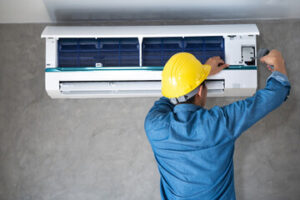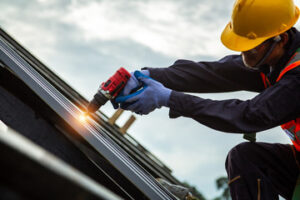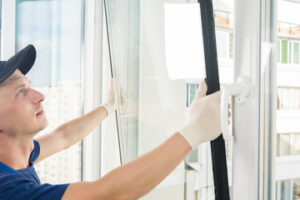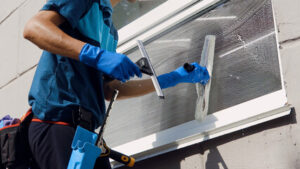Humming air conditioners have become ubiquitous, but many people don’t understand how they work or how to use them efficiently. This guide demystifies BTUs, outlines the best units for small spaces, and pinpoints features that streamline your cooling needs without a heavy energy bill.
Cincinnati Air Conditioning unit has three main mechanical components: the compressor, the condenser, and the evaporator. These parts convert refrigerant from a liquid to a gas, and back again.

1. Cools the Air
The basic function of air conditioning is to cool the air. It does this by removing heat energy from the home’s indoor air and pumping it outside, cooling the air as it does so, and then re-circulating it back into the house.
The way it does this is through a complex system of chemicals and mechanical components that include an evaporator, compressor, condenser, filters, expansion valve, muffler and thermostat. However, the central component is the refrigerant — a chemical that is capable of changing from a liquid to a gas and back again. The air conditioner’s refrigerant coils are filled with a special solution of water and Freon, but other gases like CO2 may be used in the future.
When the air is cooled it has less heat energy, and this makes it feel cooler to the touch. This coolness helps to regulate the body’s temperature, and it also allows sweat to evaporate more quickly, which further reduces heat energy.
By lowering the humidity in the room, the air is also made less hospitable to mildew and mould, which can produce allergens, irritants and toxic substances that can affect your health. As well as this, dehumidifying your air minimises condensation and stops that “musty” smell.
Another key benefit of lowered humidity is that it will help to reduce the risk of dehydration. This is because lower temperatures mean you’ll sweat less, but when you do sweat, it will be dripping off your body rather than running down your face, so you won’t lose as much moisture as you might otherwise.
One of the reasons that many people suffer from allergies to fungi like mould and mildew is because their bodies respond to them by producing antibodies, which then irritate your respiratory tract. By reducing the presence of mould and mildew in your home through the use of air conditioning, you can also reduce the symptoms of these allergies which include runny nose, itchy throat and eyes, coughing or wheezing, eye irritation and skin rash. For this reason, allergy specialists recommend that you keep your air conditioning on when you’re at home to prevent these reactions from occurring.
2. Reduces the Risk of Heat Stroke
Air conditioning is important for reducing the risk of heat stroke, which can occur when the body becomes overheated and loses the ability to regulate its temperature. People with respiratory conditions, heart disease, or other health problems are particularly vulnerable to the effects of extreme heat. By keeping the indoor temperature stable, air conditioning prevents these individuals from experiencing severe health complications and can even save their lives in cases of extreme heat stress and hot weather.
A well-functioning air conditioner also dehumidifies home air, which makes it easier for the human body to sweat and cool itself naturally. This helps prevent dehydration, which is a serious risk for those with sensitive skin or who are susceptible to heat stroke.
In addition, air conditioning systems provide a more regulated sleep environment, which is essential for good health and well-being. A cool room promotes a restful night’s sleep, which can help reduce anxiety and mood disorders. In turn, improved mental health contributes to an overall sense of wellbeing.
Additionally, regulating indoor temperatures with air conditioning can extend the lifespan of electronics and appliances. High temperatures and humidity can cause these devices to overheat, which can lead to damage and premature failure. By keeping the air cool and dry, an air conditioner prevents these issues from occurring and protects these valuable investments.
Vulnerable groups, such as infants and the elderly, are at a greater risk of developing heat-related illnesses. People who work outdoors or live in poorly insulated homes are also at increased risk of developing heat-related ailments. These individuals can experience serious health consequences such as heat exhaustion, heat cramps, and heat stroke, which can be fatal. Caregivers and family members play a vital role in the safety of these individuals during summer temperatures by ensuring air conditioning systems function properly, promoting adequate hydration, limiting exposure to extreme heat, and monitoring those at risk for health-related symptoms during hot weather.
3. Reduces the Risk of Dehydration
The lower temperatures of air conditioning reduce the risk of heat stroke, but can lead to dehydration. The loss of fluids from sweating increases the risk of a variety of health issues, including headaches and fatigue. In addition, dehydration can exacerbate existing conditions such as eczema and psoriasis. Fortunately, there are several ways to combat the effects of air conditioning and prevent dehydration. Drinking plenty of water and using a humidifier can help maintain moisture levels in the air, while eating foods with high water content can replenish body fluids.
Air conditioning is also useful for reducing the risk of respiratory problems. The low humidity created by the AC can eliminate dust and allergens, improving indoor air quality and lowering the risk of allergies and asthma. However, if the air conditioner is not cleaned regularly, it can harbor mold and mildew and contribute to respiratory issues.
Regular use of air conditioning can cause the skin to dry out, causing itching, itchy eyes and irritated mucous membranes. In addition, the constant exposure to cold temperatures can lead to muscle stiffness and reduced immunity, which could make you prone to catching infections.
The risk of respiratory problems can be reduced by adjusting the temperature, using a humidifier and consuming hydrating drinks like water, fruit juices and herbal teas. Incorporating regular exercise and taking breaks from the air-conditioned environment can also help.
Although the benefits of air conditioning are numerous, it is important to understand its negative impacts on your health and wellbeing. Regularly cleaning or replacing filters, ensuring adequate ventilation and taking frequent breaks from the air-conditioned environment can minimize these negative effects. Incorporating a well-balanced diet, drinking plenty of water and taking supplements that promote healthy hair and nails can further improve your overall health. Additionally, maintaining a healthy weight and exercising regularly can help you cope with the negative effects of air conditioning. Ultimately, it is crucial to find a comfortable temperature and take measures to protect yourself from excessive sun exposure. This will prevent the risk of heat-related illnesses and ensure that you enjoy the many benefits of air conditioning without compromising your health.
4. Reduces Noise
When an air conditioning unit is working properly, its gentle hum provides soothing comfort that lets you rest easy during the day and sleep soundly at night. However, when an AC starts making loud rattling noises that disrupt your day-to-day life, it’s probably time to do something about it. Excessive noise from an air conditioner can be caused by loose parts, build-up of dirt and debris, and overheating. Fortunately, there are several ways you can quiet an air conditioner’s unwanted clamor and restore it to its intended operating condition.
The first step to reducing the noise from your air conditioning is to check the condition of its fan blades. Loose blades can bang against the fan housing during operational rotation, causing excessive noise. Also, be sure the fan isn’t touching other components during rotation. If it does, have a professional adjust the fan base to correct the problem.
Leaking ductwork is another common cause of excessive noise from an air conditioner. When the ducts don’t seal tightly, air can leak out of the system, forcing the air conditioner to work harder to maintain a comfortable temperature. This can result in excess noise from the fans and the compressor.
A noisy air conditioner can be a real pain, especially when it occurs during the most inconvenient times. The good news is that there are a few ways to reduce the amount of noise from an air conditioner and make it more pleasant for everyone in your home.
One simple solution is to place a couple of books or rubber mats under the AC to absorb some of the vibrations that cause the noise. You can also purchase products that are designed to dampen the noise produced by a floor-standing air conditioner. These devices are similar to those used on subwoofers and will help to keep the air conditioner from vibrating through your entire house. A final option is to have a professional install acoustic panels around the unit to reduce its noise. This will cost more than some of the other methods discussed here, but it can be a relatively inexpensive way to silence your noisy AC.



